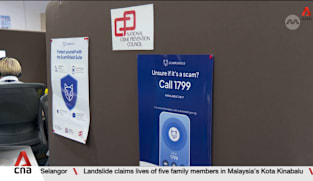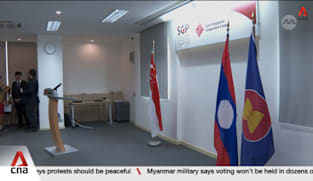Ong Ye Kung on Singapore’s mpox response plan
As of Sep 5, there have been no mpox Clade I cases in Singapore. As for the less severe mpox Clade II, 15 confirmed cases have been detected this year. Health Minister Ong Ye Kung, who gave this update in reply to MPs’ questions in Parliament on Monday (Sep 9), said although there is no Clade I case in Singapore yet, “we should expect it to arrive here at some point as it spreads beyond Africa”. Mr Ong stressed the need to respond according to the characteristics of the virus. “This is a key lesson from COVID-19,” he said. Mr Ong said if it comes here, the case fatality rate will most likely be lower and there would be better access to quality medical care. Noting that smallpox vaccination renders cross-protection against mpox, he said since smallpox vaccination was required in Singapore up till early 1981, there will be some immunity among a large segment of Singaporeans aged 45 and above. He said the best way to suppress the spread of the virus is to detect and isolate cases, and quarantine close contacts early to reduce the risk of spread to the community. Mr Ong highlighted the key aspects of Singapore’s response plan. Firstly, through border measures. Travellers must declare mpox-related symptoms and travel history on the SG Arrival Card. Authorities have also put in place temperature and visual screening for travellers arriving from higher-risk areas, at both air and sea checkpoints. Secondly, test, trace and isolate. Doctors have been told to be alert to spot and immediately report any suspected mpox Clade I case to the Ministry of Health (MOH). All suspected mpox Clade I cases will be sent to designated hospitals for further assessment and testing. If tested positive, they will be isolated in healthcare facilities until they are no longer infectious. Mr Ong said Singapore’s existing hospital capacity remains adequate to treat and isolate infected cases. Contact tracing will be conducted for all confirmed cases. The National Environment Agency will oversee environmental cleaning and disinfection for places visited by the infected cases. Close contacts of Clade I cases will be quarantined in a designated Government quarantine facility for up to 21 days from their last date of exposure. Thirdly, the schools and pre-schools have existing protocols to manage outbreaks, such as for Hand, Foot and Mouth Disease, which are relevant in an mpox Clade I outbreak. If necessary, outbreak management measures, including closures of classes, levels or the whole school, may be implemented temporarily. Fourthly, focus on vaccination for healthcare workers who need to care for mpox patients and on close contacts of infected persons. Based on this vaccination approach, Singapore’s existing supply of vaccines is projected to be sufficient, said Mr Ong. To strengthen its preparedness and resilience, MOH is looking at procuring more doses when available. Fifthly, should there be evidence of significant respiratory transmission, such as outside of households, MOH will consider implementing mask-wearing on public transport and in crowded indoor settings. Mr Ong said Singapore’s current mask stockpiles and local manufacturing capabilities will ensure that there is adequate supply. Mr Ong said MOH’s bottomline assessment is that mpox Clade I is likely a “troublesome virus” which it can manage. “However, we should not be complacent. The situation is evolving and there is still some uncertainty around the disease characteristics. We will learn more about the disease in the coming months and should be prepared to change our plans as we understand the disease more,” he said.
As of Sep 5, there have been no mpox Clade I cases in Singapore. As for the less severe mpox Clade II, 15 confirmed cases have been detected this year. Health Minister Ong Ye Kung, who gave this update in reply to MPs’ questions in Parliament on Monday (Sep 9), said although there is no Clade I case in Singapore yet, “we should expect it to arrive here at some point as it spreads beyond Africa”. Mr Ong stressed the need to respond according to the characteristics of the virus. “This is a key lesson from COVID-19,” he said. Mr Ong said if it comes here, the case fatality rate will most likely be lower and there would be better access to quality medical care. Noting that smallpox vaccination renders cross-protection against mpox, he said since smallpox vaccination was required in Singapore up till early 1981, there will be some immunity among a large segment of Singaporeans aged 45 and above. He said the best way to suppress the spread of the virus is to detect and isolate cases, and quarantine close contacts early to reduce the risk of spread to the community. Mr Ong highlighted the key aspects of Singapore’s response plan. Firstly, through border measures. Travellers must declare mpox-related symptoms and travel history on the SG Arrival Card. Authorities have also put in place temperature and visual screening for travellers arriving from higher-risk areas, at both air and sea checkpoints. Secondly, test, trace and isolate. Doctors have been told to be alert to spot and immediately report any suspected mpox Clade I case to the Ministry of Health (MOH). All suspected mpox Clade I cases will be sent to designated hospitals for further assessment and testing. If tested positive, they will be isolated in healthcare facilities until they are no longer infectious. Mr Ong said Singapore’s existing hospital capacity remains adequate to treat and isolate infected cases. Contact tracing will be conducted for all confirmed cases. The National Environment Agency will oversee environmental cleaning and disinfection for places visited by the infected cases. Close contacts of Clade I cases will be quarantined in a designated Government quarantine facility for up to 21 days from their last date of exposure. Thirdly, the schools and pre-schools have existing protocols to manage outbreaks, such as for Hand, Foot and Mouth Disease, which are relevant in an mpox Clade I outbreak. If necessary, outbreak management measures, including closures of classes, levels or the whole school, may be implemented temporarily. Fourthly, focus on vaccination for healthcare workers who need to care for mpox patients and on close contacts of infected persons. Based on this vaccination approach, Singapore’s existing supply of vaccines is projected to be sufficient, said Mr Ong. To strengthen its preparedness and resilience, MOH is looking at procuring more doses when available. Fifthly, should there be evidence of significant respiratory transmission, such as outside of households, MOH will consider implementing mask-wearing on public transport and in crowded indoor settings. Mr Ong said Singapore’s current mask stockpiles and local manufacturing capabilities will ensure that there is adequate supply. Mr Ong said MOH’s bottomline assessment is that mpox Clade I is likely a “troublesome virus” which it can manage. “However, we should not be complacent. The situation is evolving and there is still some uncertainty around the disease characteristics. We will learn more about the disease in the coming months and should be prepared to change our plans as we understand the disease more,” he said.



















